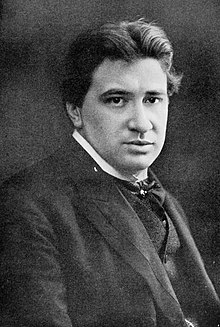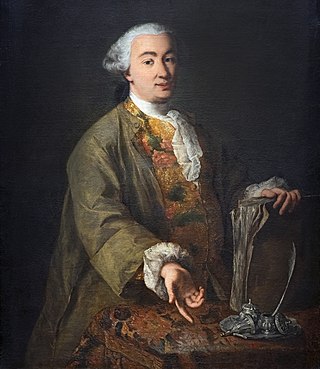
Carlo Osvaldo Goldoni was an Italian playwright and librettist from the Republic of Venice. His works include some of Italy's most famous and best-loved plays. Audiences have admired the plays of Goldoni for their ingenious mix of wit and honesty. His plays offered his contemporaries images of themselves, often dramatizing the lives, values, and conflicts of the emerging middle classes. Though he wrote in French and Italian, his plays make rich use of the Venetian language, regional vernacular, and colloquialisms. Goldoni also wrote under the pen name and title Polisseno Fegeio, Pastor Arcade, which he claimed in his memoirs the "Arcadians of Rome" bestowed on him.

Carlo, Count Gozzi was an Italian (Venetian) playwright and champion of Commedia dell'arte.
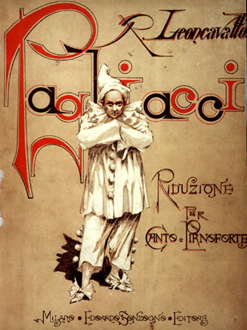
Pagliacci is an Italian opera in a prologue and two acts, with music and libretto by Ruggero Leoncavallo. The opera tells the tale of Canio, actor and leader of a commedia dell'arte theatrical company, who murders his wife Nedda and her lover Silvio on stage during a performance. Pagliacci premiered at the Teatro Dal Verme in Milan on 21 May 1892, conducted by Arturo Toscanini, with Adelina Stehle as Nedda, Fiorello Giraud as Canio, Victor Maurel as Tonio, and Mario Ancona as Silvio. Soon after its Italian premiere, the opera played in London and in New York. Pagliacci is the composer's only opera that is still widely performed.
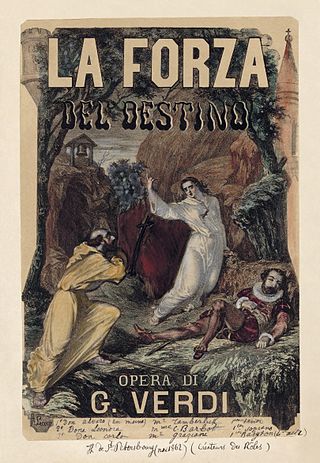
La forza del destino is an Italian opera by Giuseppe Verdi. The libretto was written by Francesco Maria Piave based on a Spanish drama, Don Álvaro o la fuerza del sino (1835), by Ángel de Saavedra, 3rd Duke of Rivas, with a scene adapted from Friedrich Schiller's Wallensteins Lager. It was first performed in the Bolshoi Kamenny Theatre of Saint Petersburg, Russia, on 29 November 1862 O.S..

The Merry Widow is an operetta by the Austro-Hungarian composer Franz Lehár. The librettists, Viktor Léon and Leo Stein, based the story – concerning a rich widow, and her countrymen's attempt to keep her money in the principality by finding her the right husband – on an 1861 comedy play, L'attaché d'ambassade by Henri Meilhac.

La Fille mal gardée is a comic ballet presented in two acts, inspired by Pierre-Antoine Baudouin's 1765 painting, La réprimande/Une jeune fille querellée par sa mère. The ballet was originally choreographed by the Ballet Master Jean Dauberval to a pastiche of music based on fifty-five popular French airs. The ballet was premiered on 1 July 1789 at the Grand Théâtre de Bordeaux in Bordeaux, France under the title Le ballet de la paille, ou Il n'est qu'un pas du mal au bien.

Life Is a Dream is a Spanish-language play by Pedro Calderón de la Barca. First published in 1636, in two different editions, the first in Madrid and a second one in Zaragoza. Don W. Cruickshank and a number of other critics believe that the play can be dated around 1630, thus making Calderón's most famous work a rather early composition. It is a philosophical allegory regarding the human situation and the mystery of life. The play has been described as "the supreme example of Spanish Golden Age drama". The story focuses on the fictional Segismundo, Prince of Poland, who has been imprisoned in a tower by his father, King Basilio, following a dire prophecy that the prince would bring disaster to the country and death to the King. Basilio briefly frees Segismundo, but when the prince goes on a rampage, the king imprisons him again, persuading him that it was all a dream.

Arlecchino, oder Die Fenster is a one-act opera with spoken dialog by Ferruccio Busoni, with a libretto in German, composed in 1913. He completed the music for the opera while living in Zurich in 1916. It is a number opera written in neo-classical style and includes ironic allusions to operatic conventions and situations typical of the late 18th and early 19th centuries. It even includes a parody of a duel.

Il viaggio a Reims, ossia L'albergo del giglio d'oro is an operatic dramma giocoso, originally performed in three acts, by Gioachino Rossini to an Italian libretto by Luigi Balocchi, based in part on Corinne ou l'Italie by Germaine de Staël.
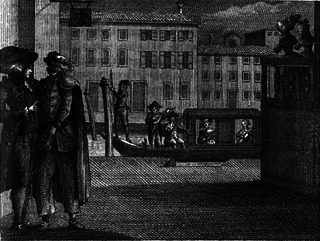
The Liar is a comedy by Carlo Goldoni. It was written as part of Goldoni's fulfilment of a boast that he had inserted into the epilogue to one of his plays that for the next season he would write sixteen comedies. The Liar, along with the fifteen other comedies, was staged in the 1750-51 season at the Teatro San Angelo in Venice. It draws on commedia dell'arte conventions and stock characters.

Turandot(BV 273) is a 1917 opera with spoken dialogue and in two acts by Ferruccio Busoni. Busoni prepared his own libretto, in German, based on the play by Count Carlo Gozzi. The music for Busoni's opera is based on the incidental music, and the associated Turandot Suite, which Busoni had written in 1905 for a production of Gozzi's play. The opera is often performed as part of a double bill with Busoni's earlier one-act opera Arlecchino.

The Antiquarian's Family, or The Mother-in-law and the Daughter is a comedy by Venetian author Carlo Goldoni, first published in 1749.
L'Orfeide is an opera composed by Gian Francesco Malipiero who also wrote the Italian libretto, partly based on the myth of Orpheus and incorporating texts by Italian Renaissance poets. The work consists of three parts – La morte delle maschere, Sette canzoni, and Orfeo, ovvero L'ottava canzone. It received its first complete performance on 5 November 1925 at the Stadttheater in Düsseldorf.
Marcello Bernardini was an Italian composer and librettist. Little is known of him, save that he wrote 37 operas in his career. His father was most likely the composer Rinaldo di Capua.
Evgueniy Alexiev is a French operatic baritone. He has lived in Bordeaux since 1992.

The Widow is a 1955 romantic drama film directed by Lewis Milestone and written by Milestone and Louis Stevens, based on the novel La Vedova by Susan York. The film had a theatrical release in Italy in 1955, limited release in the United States in 1957, and was released in France on 4 June 1959 under the title La Veuve. This was the last Milestone film involving his own writing.
La fille mal gardée, Frederick Ashton's Royal Ballet production, began in 1959 when British choreographer Frederick Ashton created a new version of La fille mal gardée for the Royal Ballet of London. This production premiered on 28 January 1960, with Nadia Nerina as Lise, David Blair as Colas, Stanley Holden as the Widow Simone, and Alexander Grant as Alain. Since its inception Ashton's staging has become a celebrated classic of the ballet repertory.

Fabrizio Clerici was an Italian painter.
Morir para vivir is a Mexican telenovela produced by Ana Martín for Televisa in 1989.
